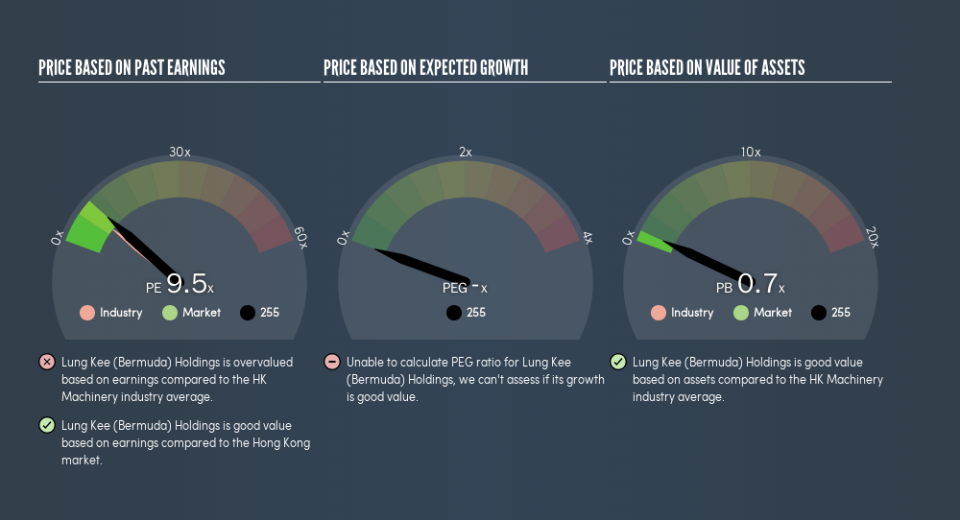Should We Worry About Lung Kee (Bermuda) Holdings Limited's (HKG:255) P/E Ratio?

Today, we'll introduce the concept of the P/E ratio for those who are learning about investing. We'll look at Lung Kee (Bermuda) Holdings Limited's (HKG:255) P/E ratio and reflect on what it tells us about the company's share price. What is Lung Kee (Bermuda) Holdings's P/E ratio? Well, based on the last twelve months it is 9.48. That corresponds to an earnings yield of approximately 11%.
See our latest analysis for Lung Kee (Bermuda) Holdings
How Do I Calculate A Price To Earnings Ratio?
The formula for P/E is:
Price to Earnings Ratio = Price per Share ÷ Earnings per Share (EPS)
Or for Lung Kee (Bermuda) Holdings:
P/E of 9.48 = HK$2.56 ÷ HK$0.27 (Based on the year to December 2018.)
Is A High Price-to-Earnings Ratio Good?
A higher P/E ratio means that investors are paying a higher price for each HK$1 of company earnings. That isn't a good or a bad thing on its own, but a high P/E means that buyers have a higher opinion of the business's prospects, relative to stocks with a lower P/E.
How Does Lung Kee (Bermuda) Holdings's P/E Ratio Compare To Its Peers?
The P/E ratio indicates whether the market has higher or lower expectations of a company. As you can see below Lung Kee (Bermuda) Holdings has a P/E ratio that is fairly close for the average for the machinery industry, which is 8.8.
Lung Kee (Bermuda) Holdings's P/E tells us that market participants think its prospects are roughly in line with its industry. So if Lung Kee (Bermuda) Holdings actually outperforms its peers going forward, that should be a positive for the share price. I would further inform my view by checking insider buying and selling., among other things.
How Growth Rates Impact P/E Ratios
Earnings growth rates have a big influence on P/E ratios. That's because companies that grow earnings per share quickly will rapidly increase the 'E' in the equation. That means unless the share price increases, the P/E will reduce in a few years. And as that P/E ratio drops, the company will look cheap, unless its share price increases.
Lung Kee (Bermuda) Holdings shrunk earnings per share by 39% over the last year. But it has grown its earnings per share by 3.3% per year over the last five years.
Remember: P/E Ratios Don't Consider The Balance Sheet
Don't forget that the P/E ratio considers market capitalization. In other words, it does not consider any debt or cash that the company may have on the balance sheet. Hypothetically, a company could reduce its future P/E ratio by spending its cash (or taking on debt) to achieve higher earnings.
Such expenditure might be good or bad, in the long term, but the point here is that the balance sheet is not reflected by this ratio.
How Does Lung Kee (Bermuda) Holdings's Debt Impact Its P/E Ratio?
With net cash of HK$728m, Lung Kee (Bermuda) Holdings has a very strong balance sheet, which may be important for its business. Having said that, at 45% of its market capitalization the cash hoard would contribute towards a higher P/E ratio.
The Verdict On Lung Kee (Bermuda) Holdings's P/E Ratio
Lung Kee (Bermuda) Holdings's P/E is 9.5 which is about average (9.9) in the HK market. Although the recent drop in earnings per share would keep the market cautious, the relatively strong balance sheet will allow the company to weather a storm; so it isn't very surprising to see that it has a P/E ratio close to the market average.
When the market is wrong about a stock, it gives savvy investors an opportunity. If it is underestimating a company, investors can make money by buying and holding the shares until the market corrects itself. We don't have analyst forecasts, but you might want to assess this data-rich visualization of earnings, revenue and cash flow.
You might be able to find a better buy than Lung Kee (Bermuda) Holdings. If you want a selection of possible winners, check out this free list of interesting companies that trade on a P/E below 20 (but have proven they can grow earnings).
We aim to bring you long-term focused research analysis driven by fundamental data. Note that our analysis may not factor in the latest price-sensitive company announcements or qualitative material.
If you spot an error that warrants correction, please contact the editor at editorial-team@simplywallst.com. This article by Simply Wall St is general in nature. It does not constitute a recommendation to buy or sell any stock, and does not take account of your objectives, or your financial situation. Simply Wall St has no position in the stocks mentioned. Thank you for reading.

